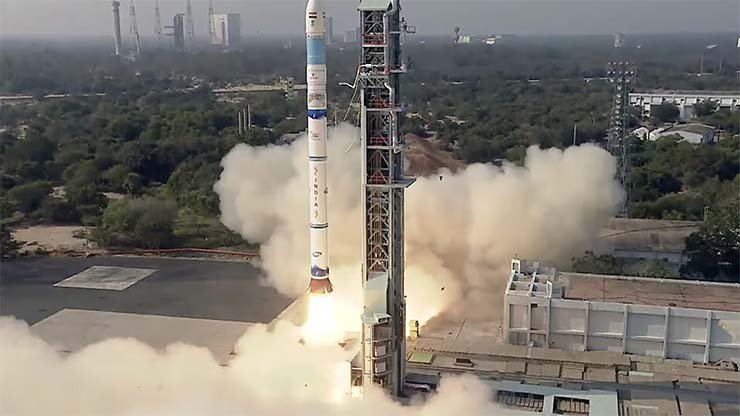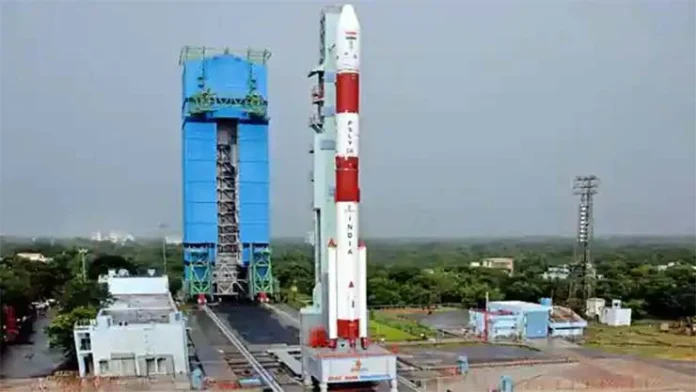In the morning hours of February 10, 2023, Indian Space Research Organisation (ISRO) once again made the country proud and added another feather to its cap. ISRO did a successful launch of the Small Satellite Vehicle (SSLV) from the First Launch Pad of Satish Dhawan Space Centre, Sriharikota. The mission placed all three satellites into their designated 450 km altitude circular orbits. SSLV is a three-stage Launch Vehicle configured with three Solid Propulsion Stages and a liquid propulsion-based Velocity Trimming Module (VTM) as a terminal stage. Within minutes of launch, ISRO confirmed that all three stages functioned satisfactorily.
Congratulations to ISRO for adding a new member to its launch vehicle fleet! GSLV, PSLV and now we have the SSLV!
It is actually a big achievement to have achieved success in its second launch itself. In its first attempt on August 7, 2022, the SSLV-D1 failed to place its payload of two smallsats into the proper orbit. ISRO undertook a thorough investigation.
Investigation revealed that at the time of the second stage separation, vibrations were stronger and also lasted longer than expected, thereby overwhelming all the six accelerometers onboard. This caused the guidance system to assume that the accelerometers had malfunctioned, resulting in the guidance system initiating a salvage mode, ignoring data from the accelerometers. That included open-loop guidance of the rocket’s third stage without using feedback from those accelerometers. All this led to reduced velocity and as a result, both its payloads ended up in a major deviation causing them to reenter the atmosphere immediately. ISRO stated that all the accelerometers in fact were not damaged and functioned normally for the rest of the flight.
ISRO took several corrective design changes to prevent a recurrence, it changed the stage separation system to the one already being used for the third stage that produces less shock. ISRO adopted a new approach to handling accelerometer data in the guidance system, including waiting longer before concluding that the accelerometers have malfunctioned and triggering the salvage mode.
Corrective actions by ISRO indeed proved successful. Three satellites onboard have been healthy and have now commenced their operations. Satellites onboard the SSLV-D2 mission were EOS-7, Janus-1 and AzadiSAT-2 satellites.
The EOS-07 is a 156.3 kg, experimental satellite, developed by ISRO with the mission objectives of developing and demonstrating new instruments like the mm-wave Humidity Sounder and the Spectrum Monitoring Payload.
Janus-1, a 10.2 kg satellite, has been built by the Indian-American company Antaris, and is a technology demonstrator, ‘smart satellite’.
Like its predecessor, AzaadiSAT-2, weighing 8.7 kg has been built by 750 girl students from across India, guided by Space Kidz India, Chennai. It is meant to demonstrate LoRa and amateur radio communication capabilities, it will measure radiation levels in space and demonstrate an expandable satellite structure.
SSLV is configured with three solid-stage motors of 87 t, 7.7 t and 4.5 t. The satellite insertion into the intended orbit is achieved through a liquid propulsion-based velocity trimming module (VTM).
With a height of 34 m and 2 m dia SSLV can lift off a mass of 120 tonnes, capable of launching satellites of 10 to 500 kg mass, to a 500 km planar orbit. It offers the country a new launch option.

A capability like SSLV opens various new avenues and has interesting implications for the nation. Earlier smaller satellites were being launched on a Polar Satellite Vehicle (PSLV) on a ride-sharing arrangement. Thus they had to wait for the satellite bus to be gainfully populated. With the success of SSLV, PSLV – the most reliable workhorse of the ISRO – can concentrate on heavier launches.
SSLV costs less, thus will provide low-cost access to Space. It has a low turnaround of just 72 hours (compared to 45-60 days for PSLV with the involvement of 600 people). Faster assembly gives it ‘launch on demand’ capability (LoD), this actually is a huge strategic differentiator in the space domain.
There is a sound realisation amongst military thinkers and practitioners alike that the victor in any future conflict would be the one who is most efficiently able to exploit the space domain. Satellites continue to demonstrate how important space is to today’s military missions. They provide surveillance, space situational awareness, positioning & navigational (PNT services) information and communication to inform the military movement as was evidenced by the real-time satellite feeds that tracked Russia’s troop movement during the early days of the invasion of Ukraine. That precise and timely surveillance gave Ukraine’s defence forces an advantage.
Despite versatile utility, today’s satellites remain vulnerable to attacks. Also, there may be a requirement to launch satellites at short notice due to varying operational compulsions. Indigenous LoD capability offers a high level of strategic capability. It was during the Gulf War that the US launched small satellites, Key Hole, KH-8, 9 and 10 in quick succession to closely bring Iraqi forces under surveillance during a major offensive. India has established the Defence Space Agency (DSA) to address all defence space requirements including the protection of all its space assets. DSA is known to be aggressively pushing the case for SSLV. The development of SSLV is a significant strategic achievement in the space domain. SSLV capability would enable the nation to ensure safe, secure and assured use of the space domain to serve our national interests while our adversary attempts to disrupt the use of our space assets. SSLV has the potential to form the backbone of defence space industry enterprise.
An EY-ISpA report titled ‘Developing the space ecosystem in India: focusing on inclusive growth’ brings out that by 2025, satellite manufacturing will be the second fastest growing segment in the Indian space economy, with launch services growing the fastest.
Over the years, India has become a leader in launch services. India boasts of one of the highest launch success rates in the world for PSLV. Developing SSLV capability is going to prove an important lynchpin for the growth of the Indian space sector.
The SSLV is meant to meet the needs of the emerging small and microsatellite commercial market and offer launches on demand. In order to take this capability to its logical commercial fructification, there is an urgent requirement to populate the SSLV technology to Indian private companies like in the case of PSLV. New Space India Limited (NSIL) in September 2022 signed Rs 860 crore agreement with the HAL-L&T consortium for end-to-end manufacturing of five PSLV in four years.
SSLV offers a great opportunity to the armed forces as well as the civilian commercial world. It has the potential to lead to path-breaking capabilities. Full compliments to ISRO for having achieved this capability. It need not rest on its laurels now, true professionalism lies in ISRO commercialising SSLV production, on priority.
-The writer is an IAF veteran and has been involved in air operations, intelligence and strategic matters. He has served as Assistant Chief of Air Staff (Off Ops) at Air HQ and Assistant Chief of Integrated Defence Staff (Tech Int) at HQ – IDS, appointments related to offensive operations, UAV, space and ISR matters. The views expressed are of the writer and do not necessarily reflect the views of Raksha Anirveda
–The writer is an IAF veteran and has been involved in air operations, intelligence and strategic matters. He has served as Assistant Chief of Air Staff (Off Ops) at Air HQ and Assistant Chief of Integrated Defence Staff (Tech Int) at HQ – IDS, appointments related to offensive operations, UAV, space and ISR matters. The views expressed are of the writer and do not necessarily reflect the views of Raksha Anirveda






